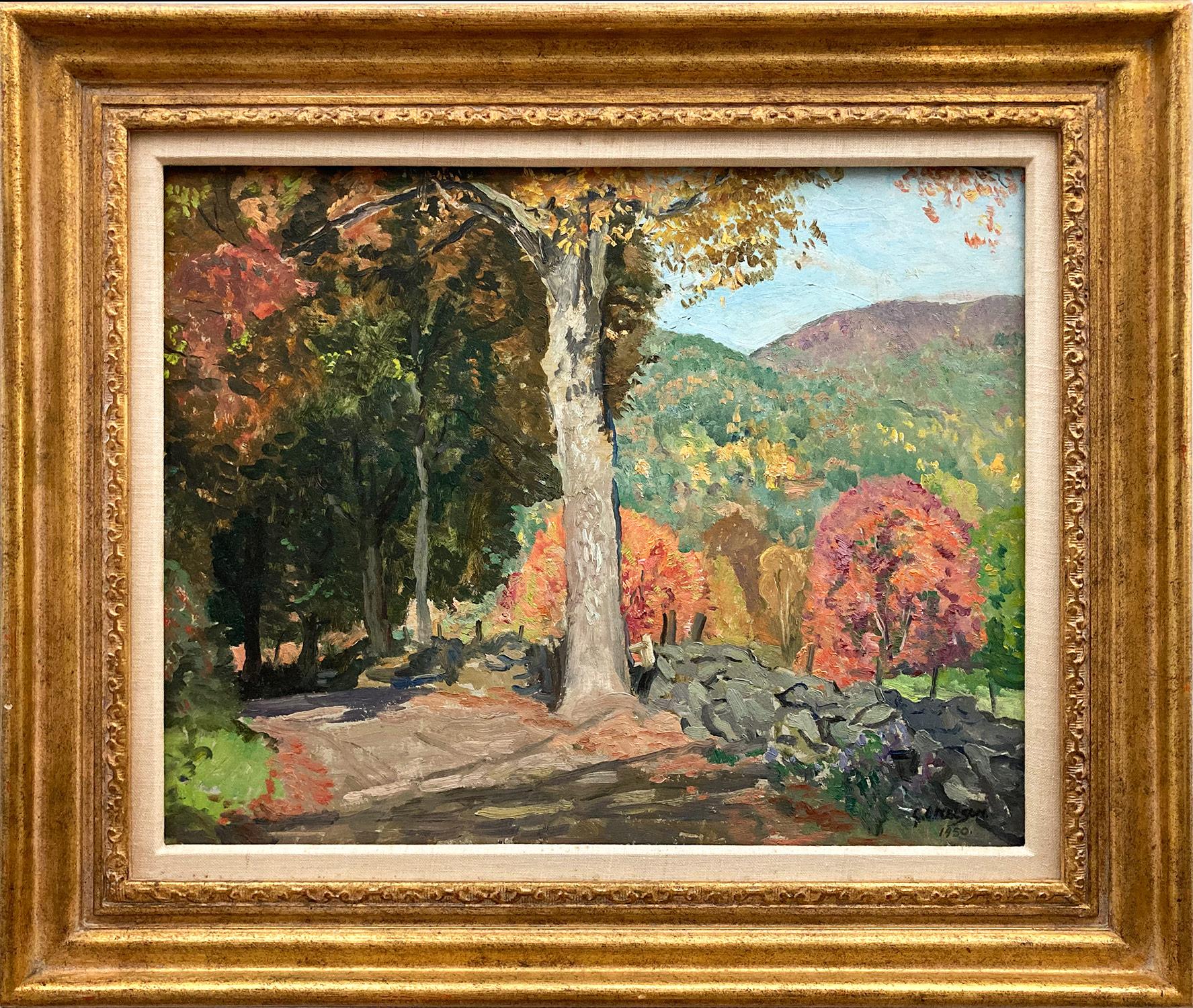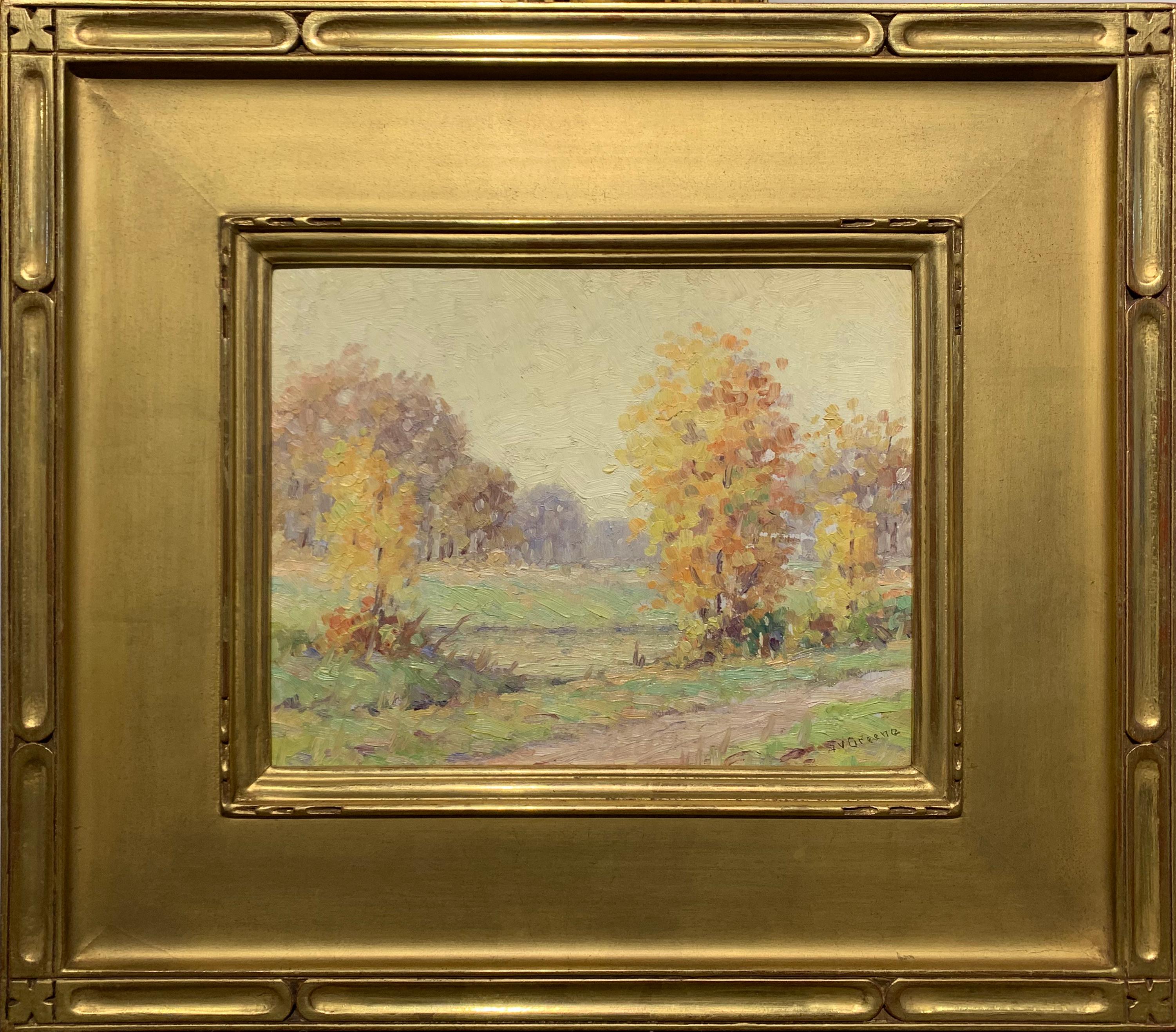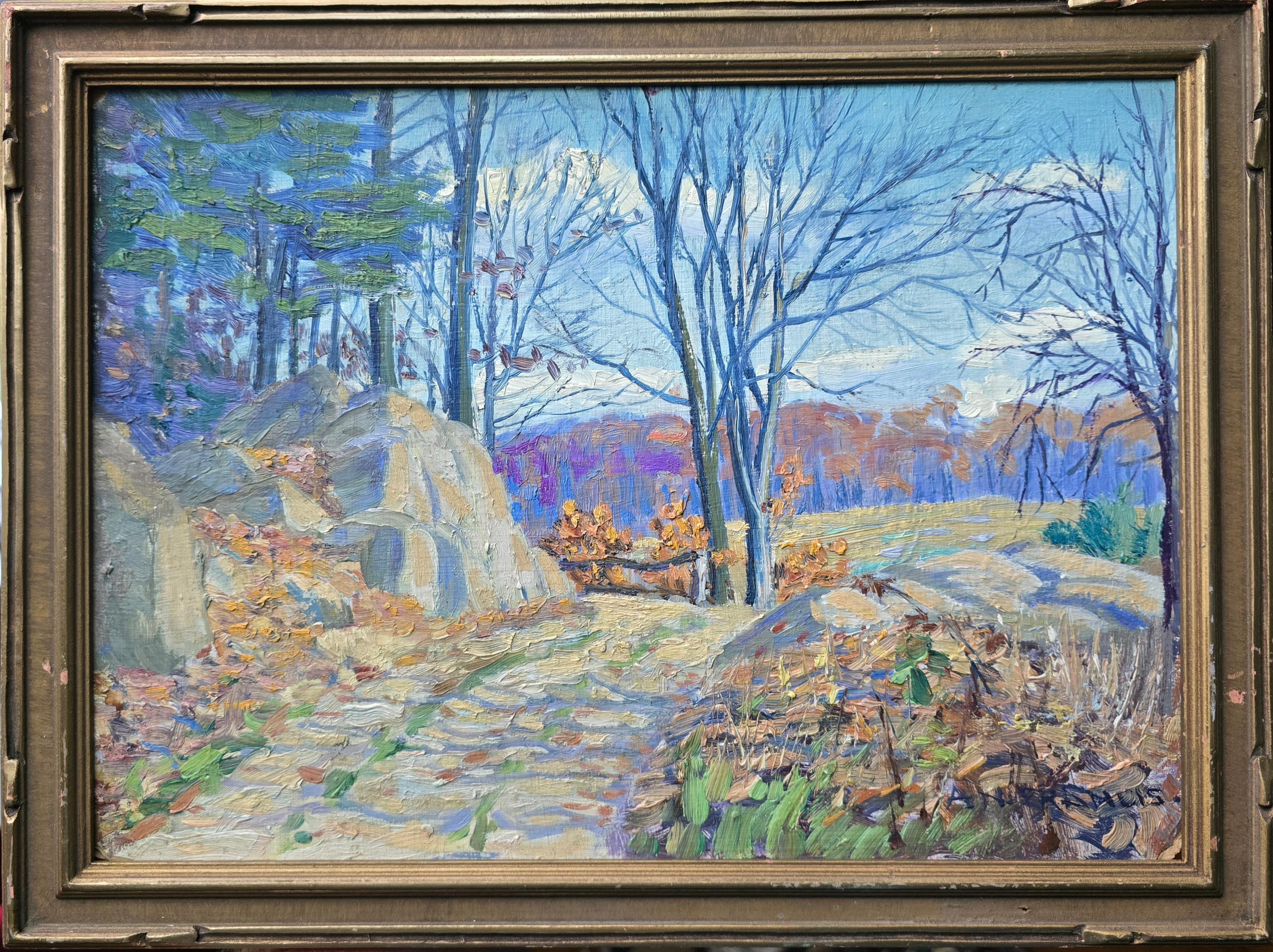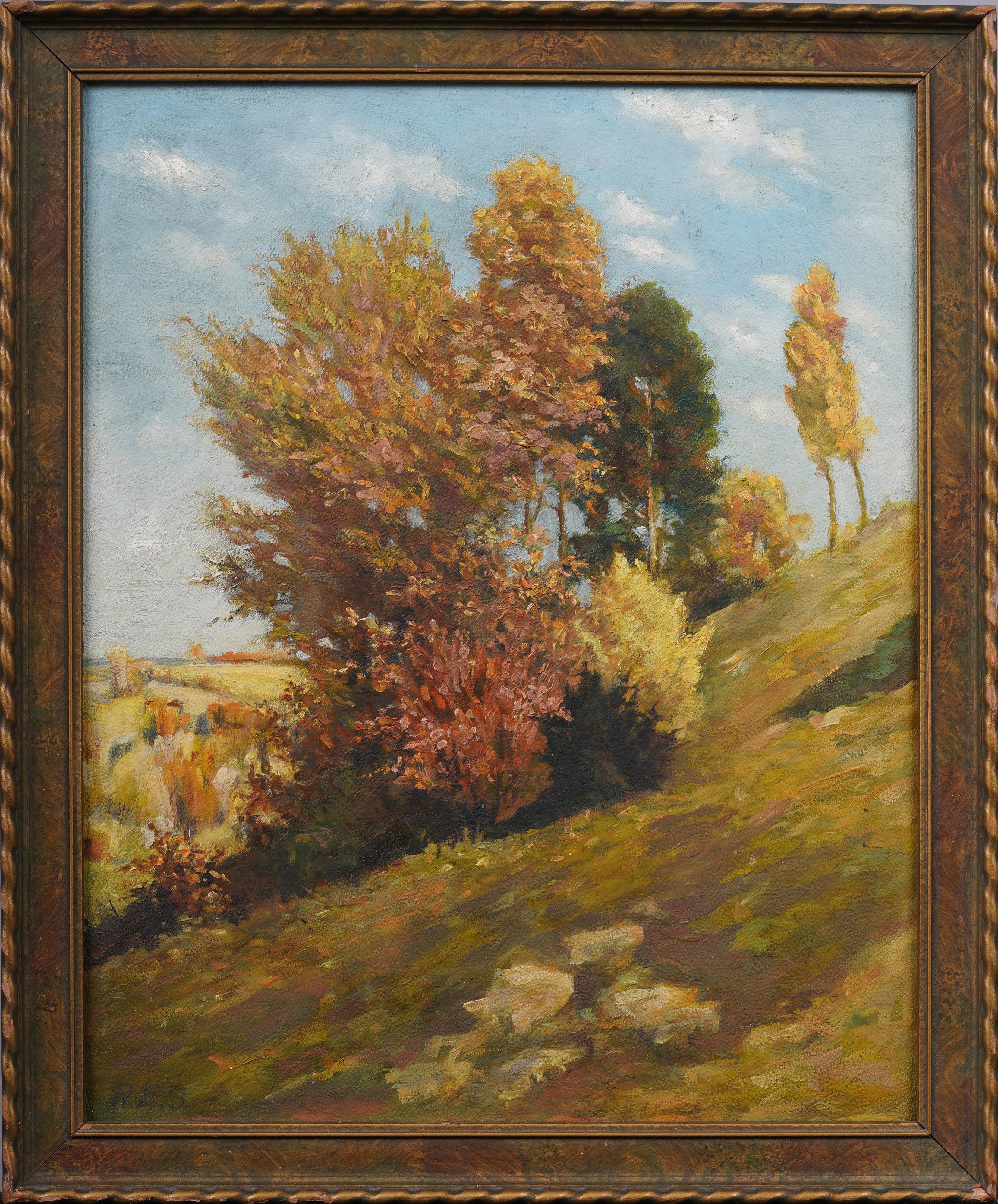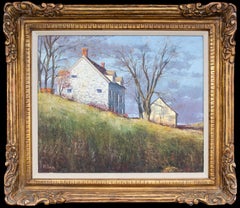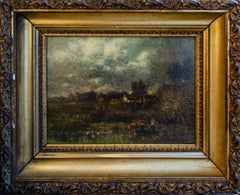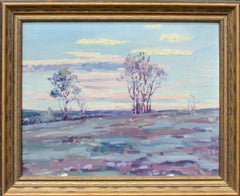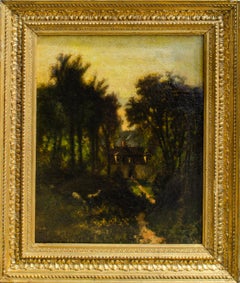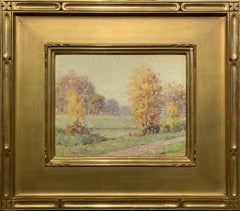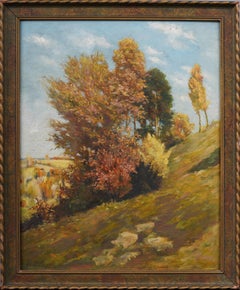Items Similar to Autumn Landscape Painting Signed by W.E. Beatty
Want more images or videos?
Request additional images or videos from the seller
1 of 8
W.E. BeattyAutumn Landscape Painting Signed by W.E. Beatty20th Century
20th Century
$900
£677.17
€782.14
CA$1,271.93
A$1,380.24
CHF 731.41
MX$16,928.01
NOK 9,051.11
SEK 8,552.82
DKK 5,839.08
About the Item
W.E. Beatty
Untitled (Autumn Landscape), c. 20th century
Oil on canvas
16 x 20 in.
Framed: 22 1/2 x 26 1/2 in.
Signed lower right: W E BEATTY
- Creator:W.E. Beatty (American)
- Creation Year:20th Century
- Dimensions:Height: 22.5 in (57.15 cm)Width: 26.5 in (67.31 cm)Depth: 0.5 in (1.27 cm)
- Medium:
- Movement & Style:
- Period:
- Condition:Considerable craquelure,.
- Gallery Location:New York, NY
- Reference Number:Seller: BL51stDibs: LU2211211969532
About the Seller
5.0
Platinum Seller
Premium sellers with a 4.7+ rating and 24-hour response times
1stDibs seller since 2022
91 sales on 1stDibs
Typical response time: <1 hour
- ShippingRetrieving quote...Shipping from: New York, NY
- Return Policy
Authenticity Guarantee
In the unlikely event there’s an issue with an item’s authenticity, contact us within 1 year for a full refund. DetailsMoney-Back Guarantee
If your item is not as described, is damaged in transit, or does not arrive, contact us within 7 days for a full refund. Details24-Hour Cancellation
You have a 24-hour grace period in which to reconsider your purchase, with no questions asked.Vetted Professional Sellers
Our world-class sellers must adhere to strict standards for service and quality, maintaining the integrity of our listings.Price-Match Guarantee
If you find that a seller listed the same item for a lower price elsewhere, we’ll match it.Trusted Global Delivery
Our best-in-class carrier network provides specialized shipping options worldwide, including custom delivery.More From This Seller
View All1970s Farmhouse Painting Along NY 201, Autumn Scene by Max Millman
Located in New York, NY
Max Millman (American, ?-1998)
Along Route 201, 1976
Oil on canvas
20 x 24 in.
Framed: 27 3/4 x 32 x 2 in.
Signed lower left: Miller
Titled, dated verso: Along Route 201 [Possibly 20...
Category
1970s American Impressionist Landscape Paintings
Materials
Canvas, Oil
Charles Henry Miller Hudson River School landscape of Queens, NY
By Charles Henry Miller
Located in New York, NY
Charles Henry Miller (American, 1842-1922)
Untitled, c. Late 1800s-Early 1900s
Oil on board
9 x 12 in.
Framed: 14 5/8 x 17 3/4 in.
Signed lower right: C.H. Miller
Charles Henry Miller was a noted artist and painter of landscapes from Long Island, New York. The American poet Bayard Taylor called him, "The artistic discoverer of the little continent of Long Island."
Miller was educated at Mount Washington Collegiate Institute, and graduated in medicine at the New York Homeopathic Institute in 1864. Before his graduation, he had occasionally painted pictures, and in 1860 he exhibited The Challenge Accepted at the National Academy of Design, in New York City.
He lived in Queens at the summer estate, Queenslawn, originally purchased by his parents. He went abroad in 1864 and again in 1867, and was a pupil in the Bavarian Royal Academy at Munich under the instruction of Adolf Lier.
After the 1874 death of his father, Jacob Miller, who was a wealthy architect and builder, Miller received a large inheritance that allowed him to paint as an independent artist for the remainder of his long life. He worked seriously and exhibited regularly, including at international exhibitions.
The majority of his oil paintings depict Long Island subjects, especially those in and around Queens Village. Fed up with the development of the eastern part of Queens (present-day Nassau County), he began to spend part of his summers in East Marion, Long Island, c. 1910. Here he spent his time sketching and painting the surrounding areas.
In 1885 he published The Philosophy of Art in America, using the pseudonym Carl De Muldor (he was descended from the De Muldor family).
His work was recognized: in 1873, he was elected an associate of the National Academy of Design and an academician in 1875. He served as president of the New York Art Club in 1879 and of the American Committee at the Munich International Exposition in 1883.
Legacy and honors
• In 1910 Miller founded the Queens Borough Allied Arts & Crafts Society.
• A New York City public school, Queens P.S. 33, was once named for him.
• 1878, gold medal awarded by the Massachusetts Charitable Association
• 1885, gold medal at the World's Exposition in New Orleans.
Following is a list, which includes many of his known exhibitions:
• National Academy of Design, New York, NY, 1860-61, 1865-67, 1870-1921
• Brooklyn Art Association, Brooklyn, NY, 1872-84, 1891-92
• Artist's Fund Society, New York, NY, 1874 (exhibition & sale), 1886 (exhibition & sale)
• Century Association, New York, NY, (1874-1917)
• Philadelphia Centennial Exhibition, Philadelphia, PA, 1876 (prize)
• Society of American Artists, New York, NY, (1878-1882)
• Massachusetts Charitable Mechanic Association, Boston, MA, 1878 (prize)
• Paris International Exposition, Paris, France, 1878, 1889
• American Water Color Society Exhibition, New York, NY, 1879
• Pennsylvania Academy of Fine Arts, Philadelphia , PA, 1879-99
• Boston Art Club, Boston, MA, 1880-1907 (prize)
• Union League Club, New York, NY, 1880
• Lotos Club, New York, NY, 1880, 1896, 1899-1900, 1906
• Salons of Paris, Paris, France, 1882
• International Exhibition, Munich, Germany, 1883 (president & exhibitor)
• New Orleans Exposition, New Orleans, LA, 1885 (prize)
• Art Institute of Chicago, Chicago, IL, 1888-89, 1891, 1894-98, 1904
• Fifth Avenue Art Gallery, New York, NY, 1889 (exhibition & sale)
• World's Columbian Exposition, Chicago, IL, 1892
• Frederick A. Chapman Gallery, New York, NY, 1898 (solo)
• Miller Studio...
Category
Early 20th Century American Impressionist Landscape Paintings
Materials
Canvas, Foam, Oil
Dreamy Pastel Landscape by Mystery American Artist
Located in New York, NY
Mystery American Artist
Untitled, c. 20th Century
Oil on board
11 x 14 in.
Framed: 13 2/3 x 16 2/3 x 1 1/4 in.
Category
20th Century American Impressionist Landscape Paintings
Materials
Oil, Board
Charles Henry Miller Tonalist Countryside landscape Painting 1876
Located in New York, NY
Countryside, 1876
Oil on canvas
13 1/2 x 11 in.
Framed: 17 1/2 x 15 x 1 1/2 in.
Signed lower left and dated 1876
Category
1870s English School Landscape Paintings
Materials
Canvas, Oil
Charles Henry Miller Impressionist Landscape Oil Painting
By Charles Henry Miller
Located in New York, NY
Charles Henry Miller (American, 1842-1922)
Untitled (New York Landscape), c. 1900
Oil on canvas laid on foam
6 1/8 x 10 5/8 in.
Signed lower left: C.H.M.
Charles Henry Miller was a noted artist and painter of landscapes from Long Island, New York. The American poet Bayard Taylor called him, "The artistic discoverer of the little continent of Long Island."
Miller was educated at Mount Washington Collegiate Institute, and graduated in medicine at the New York Homeopathic Institute in 1864. Before his graduation, he had occasionally painted pictures, and in 1860 he exhibited The Challenge Accepted at the National Academy of Design, in New York City.
He lived in Queens at the summer estate, Queenslawn, originally purchased by his parents. He went abroad in 1864 and again in 1867, and was a pupil in the Bavarian Royal Academy at Munich under the instruction of Adolf Lier.
After the 1874 death of his father, Jacob Miller, who was a wealthy architect and builder, Miller received a large inheritance that allowed him to paint as an independent artist for the remainder of his long life. He worked seriously and exhibited regularly, including at international exhibitions.
The majority of his oil paintings depict Long Island subjects, especially those in and around Queens Village. Fed up with the development of the eastern part of Queens (present-day Nassau County), he began to spend part of his summers in East Marion, Long Island, c. 1910. Here he spent his time sketching and painting the surrounding areas.
In 1885 he published The Philosophy of Art in America, using the pseudonym Carl De Muldor (he was descended from the De Muldor family).
His work was recognized: in 1873, he was elected an associate of the National Academy of Design and an academician in 1875. He served as president of the New York Art Club in 1879 and of the American Committee at the Munich International Exposition in 1883.
Legacy and honors
• In 1910 Miller founded the Queens Borough Allied Arts & Crafts Society.
• A New York City public school, Queens P.S. 33, was once named for him.
• 1878, gold medal awarded by the Massachusetts Charitable Association
• 1885, gold medal at the World's Exposition in New Orleans.
Following is a list, which includes many of his known exhibitions:
• National Academy of Design, New York, NY, 1860-61, 1865-67, 1870-1921
• Brooklyn Art Association, Brooklyn, NY, 1872-84, 1891-92
• Artist's Fund Society, New York, NY, 1874 (exhibition & sale), 1886 (exhibition & sale)
• Century Association, New York, NY, (1874-1917)
• Philadelphia Centennial Exhibition, Philadelphia, PA, 1876 (prize)
• Society of American Artists, New York, NY, (1878-1882)
• Massachusetts Charitable Mechanic Association, Boston, MA, 1878 (prize)
• Paris International Exposition, Paris, France, 1878, 1889
• American Water Color Society Exhibition, New York, NY, 1879
• Pennsylvania Academy of Fine Arts, Philadelphia , PA, 1879-99
• Boston Art Club, Boston, MA, 1880-1907 (prize)
• Union League Club, New York, NY, 1880
• Lotos Club, New York, NY, 1880, 1896, 1899-1900, 1906
• Salons of Paris, Paris, France, 1882
• International Exhibition, Munich, Germany, 1883 (president & exhibitor)
• New Orleans Exposition, New Orleans, LA, 1885 (prize)
• Art Institute of Chicago, Chicago, IL, 1888-89, 1891, 1894-98, 1904
• Fifth Avenue Art Gallery, New York, NY, 1889 (exhibition & sale)
• World's Columbian Exposition, Chicago, IL, 1892
• Frederick A. Chapman Gallery, New York, NY, 1898 (solo)
• Miller Studio...
Category
Early 20th Century American Impressionist Landscape Paintings
Materials
Canvas, Foam, Oil
Charming Small-scale Landscape by James GH Spindler, Royal Scottish Academy
Located in New York, NY
James Gustavus Hope Spindler (Scottish, 1862-1916)
Untitled, 1913
Oil on board
7 x 9 3/4 in.
Frame: 15 x 17 3/4 x 2 1/4 in.
Signed and dated lower left: James GH Spindler 1913
James...
Category
1910s English School Landscape Paintings
Materials
Oil, Board
You May Also Like
"Autumn" Colorful Mid-20th Century American Oil Painting Landscape with Tress
Located in New York, NY
A wonderful depiction of an Autumn landscape in Kent, Connecticut from the Mid-20th Century with puffed trees by the country side. For this beautiful depiction, we find distinct elements that are unique to the earlier works of George Lawrence...
Category
1950s American Impressionist Landscape Paintings
Materials
Oil, Board, Canvas
Autumn on Canal, American Impressionist Landscape, Oil on Board, Signed
By Albert Van Nesse Greene
Located in Doylestown, PA
"Autumn on Canal" is a Pennsylvania landscape by American Impressionist painter Albert Van Nesse Greene.
The painting is a 8" x 10" oil on board, framed, and signed "A V Greene...
Category
Early 20th Century American Impressionist Landscape Paintings
Materials
Oil, Board
Autumn Road - Albert N. Francis
Located in North Clarendon, VT
Colorfull and well painted oil on board by American Impressionist Albert N. Francis. Exhibited in 1919 at a Worcester Art Museum exhibition, exhibition label verso. Housed in a per...
Category
1910s American Impressionist Paintings
Materials
Oil
Antique American Impressionist Fall Landscape Signed Framed New England Painting
Located in Buffalo, NY
Impressive early American impressionist landscape oil painting. Framed. Oil on board. Signed in monogram. Image size, 12H by 16L.
Category
Early 1900s Impressionist Landscape Paintings
Materials
Canvas, Oil
$620 Sale Price
20% Off
Finely Painted Framed Antique American Impressionist Fall Landscape Oil Painting
Located in Buffalo, NY
Antique American impressionist landscape oil painting. Oil on canvas. Signed. Framed. Measuring 20 by 25 inches overall and 16 by 20 painting alone.
Category
Early 1900s Impressionist Landscape Paintings
Materials
Canvas, Oil
Antique American Impressionist Oil Painting Fall Landscape Original Carved Frame
Located in Buffalo, NY
An antique American Woodstock school landscape painting in an original hand carved period wood frame.
Unsigned but clearly done by a very masterful hand.
Category
1930s American Impressionist Landscape Paintings
Materials
Canvas, Oil
More Ways To Browse
Creek Oil Painting
German Impressionist
Knife Oil Paintings
Normandy Painting
Nude Self Portrait
Pink House
Regine David
San Francisco Golden Gate Bridge
Scottish Highlands Paintings
South Of France Painting
Swiss Oil Paintings
20th C Impressionist Paintings
Colorado Landscape Paintings
Impressionist Ocean Oil Paintings
Pioneer Paintings
Seine Oil Painting
City Street Painting
Harbor Boat Painting
